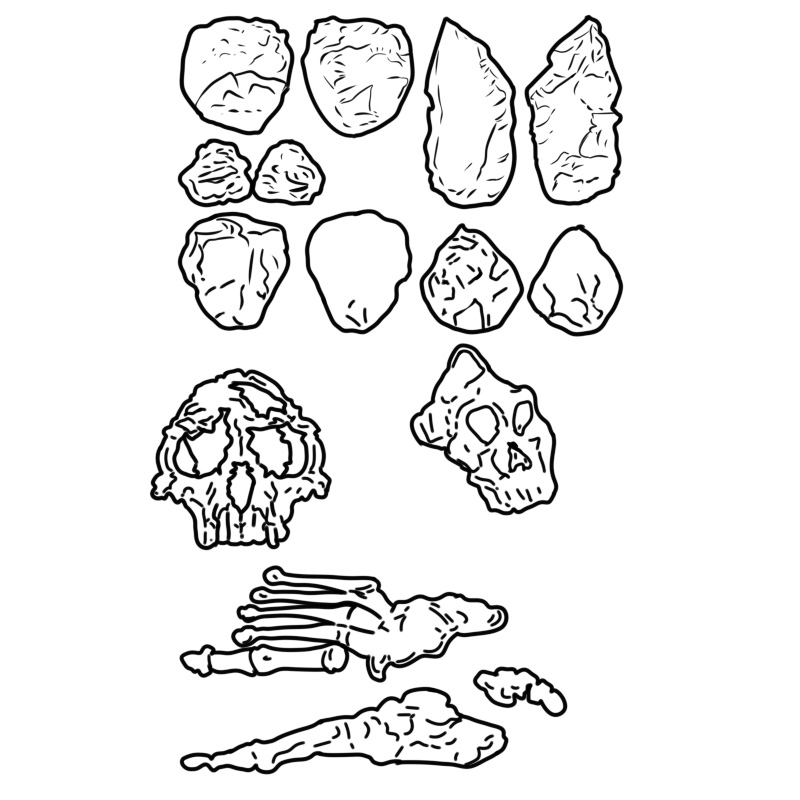Despite seeming like a relatively stable place, the Earth's surface has changed dramatically over the past 4.6 billion years. Mountains have been built and eroded, continents and oceans have moved great distances, and the Earth has fluctuated from being extremely cold and almost completely covered with ice to being very warm and ice-free. As these changes have occurred, organisms have evolved. How do you think scientists piece together these changes to study the evolutionary history of the earth and its organisms? This is made possible through the field of scientific investigation called 'geochronology' which will be discussed in this lesson.
Upon completion of this topic, you are expected to;

Geochronology is the science of establishing the age of sediments, fossils and rocks using signatures inherent in these rocks. Radioactive isotopes can help accomplish absolute geochronology, whereas tools like stable isotope ratios and palaeomagnetism provide relative geochronology. The precision of the recovered age may be improved by combining different geochronological indicators.
Geochronology is different from biostratigraphy in terms of application. Biostratigraphy refers to the science of assigning a known geological period to sedimentary rocks through describing, cataloging as well as comparing fossil faunal and floral assemblages. Biostratigraphy does not provide an absolute determination of the age of rock directly, it merely places the age of a rock in an interval of time at which the assemblage of that fossil is known to have coexisted. Both geochronology and biostratigraphy share the same system of naming strata (rock layers) and the time spans utilized to classify sublayers within a stratum.
RADIOMETRIC DATING. This is done by measuring a radioactive isotope’s amount of radioactive decay with a known half-life. Radiometric dating can help geologists establish the absolute age of parent material. Different radioactive isotopes are used for radiometric dating. Based on the rate of decay, different radioactive isotopes are used for different geological periods. Isotopes that decay slowly are used for longer time periods, but they are less accurate in absolute years. Apart from radiocarbon method, many of these techniques are based on measuring an increase in the decay product known as radiogenic isotope. Some of the most common techniques are:
FISSION-TRACK DATING. This method is a radiometric dating technique based on analyses of the damage trails, or tracks, left by fission fragments in certain uranium-bearing minerals and glasses.
COSMOGENIC NUCLIDE GEOCHRONOLOGY. This method uses exotic nuclides such as 10Be, 36Cl, and 26Al produced by cosmic rays that interact with earth materials as a proxy for the age when a surface was created.
CHEMOSTRATIGRAPHY. This uses the global trends in the composition of isotopes mainly carbon-13 to correlate strata.
MAGNETOSTRATIGRAPHY. This method establishes age from the pattern of magnetic polarity zones in a series of sedimentary or volcanic rocks by comparison to a timescale of magnetic polarity.
PALEOMAGNETIC DATING. This is the study of the record of the Earth's magnetic field in rocks, sediment, or archeological materials. Magnetic minerals in rocks can lock-in a record of the direction and intensity of the magnetic field when they form.
INCREMENTAL DATING. This technique allows the construction of annual year-by-year chronologies which can be floating or fixed (linked to the present day).
LUMINESCENCE DATING. This technique uses light that is emitted from materials like calcite, diamond, feldspar and quartz.
GEOLOGICAL HIERARCHY OF CHRONOLOGICAL PERIODIZATION
The geologic time scale (GTS) is a system of chronological dating that related geological strata to time. It is used by geologists, paleontologists, and other Earth scientists to describe the timing and relationships of events that have occurred during Earth's history.
The geological hierarchy of chronological periodization from largest to smallest:
The primary defined divisions of time are eons, in sequence the Hadean, the Archean, the Proterozoic and the Phanerozoic. The first three of these can be referred to as collectively as the Precambrian supereon. Eons are divided into eras, which are in turn divided into periods, epochs and ages.
An era is a span of time defined for the purposes of chronology, as a calendar era used for a given calendar, or the geological eras defined for the history of Earth.
A geological period is one of the several subdivisions of geologic time enabling cross-referencing of rocks and geologic events from place to place. These periods form elements of a hierarchy of divisions into which geologists have split the Earth's history.
Epoch is an instant in time chosen as the origin of a particular calendar era. The "epoch" serves as a reference point from which time is measured.
A geologic age is a subdivision of geologic time that divides an epoch into smaller parts.
Chron represents a certain time period in geologic history where the Earth's magnetic field was in predominantly a "normal" or "reversed" position. Chrons are numbered in order starting from today and increasing in number into the past. As well as a number, each chron is divided into two parts, labeled "n" and "r", thereby showing the position of the field's polarity.
The below table lists the units in geochronology in terms of the rock segment in which a geochronological time span is studied.
| Segments of rocks | Time spans in geochronology | Notes to geochronological units |
| Eonothem | Eon | 4 total, half a billion years or more |
| Erathem | Era | 10 defined, several hundred million years |
| System | Period | 22 defined, tens to ~one hundred million years |
| Series | Epoch | 34 defined, tens of millions of years |
| Stage | Age | 99 defined, millions of years |
| Chronozone | Chron | subdivision of an age, not used by the ICS timescale |